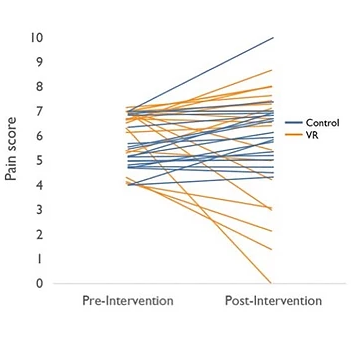Virtual Reality Reduces Pain in Laboring Women

Virtual reality represents a potential method for easing labor pain and in non-pregnant patients has been shown to achieve similar or greater analgesia than opioids. Few studies of VR have been performed in pregnant women. In a study led by Drs. Melissa Wong and Kim Gregory in our Ob/Gyn department, our team at Cedars-Sinai performed a randomized controlled trial to evaluate whether VR is effective in reducing pain in laboring women.
In this study, we included women with a pain score level of 4 to 7 having regular contractions at least every 5 minutes during childbirth. We excluded women who had received any pharmacologic pain relief prior to being considered for the study. Participants were randomized to up to 30 minutes of either VR or the control arm (no additional intervention). Then we measured pain scores before vs. after receiving the intervention.
There were forty subjects enrolled in the study; 19 were randomized to control and 21 to the VR arm. Most baseline characteristics were similar between groups. For the primary outcome, those assigned to the control arm had a statistically significant increase in pain of +0.58, while the VR arm had a significant reduction in pain of -0.52 (p = 0.03). There was also a difference in the proportion who had a minimum clinically important difference in pain (0% control and 23.8% VR; p = 0.049). Postintervention maternal heart rate was higher in the control arm (86.8 vs. 76.3, p = 0.01). Most other secondary outcomes did not differ.
In short, we found that VR was effective for reducing pain in women in labor as compared with those receiving no intervention. VR represents a non-pharmacologic option for pain relief that should be offered to assist with childbirth among women willing to try the technology.
February 20, 2020



